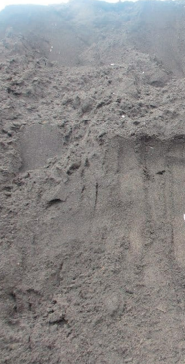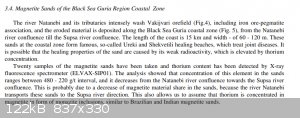
samarium14 - 11-8-2022 at 03:02
Hello! I'm just interested if it is worth working on sand that contains Th con. 200 g/t - 450 g/t. If it is worth the work, I can go to a particular
strip of the Black Sea coast and take several kilos of this sand.
the sand:

[Edited on 11-8-2022 by vano]
Edit by Texium: added details to thread title
[Edited on 8-11-2022 by Texium]
Σldritch - 11-8-2022 at 06:04
Worth? Probably not, but if you want to have fun trying to separate the Thorium maybe you could improve your results by only collecting the sand that
you can pick up with a magnet. That may give you a rare-earth richer sample, or just a bunch of iron, I don't know. It is Monazite sand, right? It is
apparently paramagnetic.
samarium14 - 11-8-2022 at 06:15
thanks! I don't know its name. people call it magnetic sand. The river washes the ore and brings it to the beach.
clearly_not_atara - 11-8-2022 at 06:31
Make sure you have an excellent particle filter mask. Thorium outside the body is not dangerous, but thorium in the lungs is a serious hazard.
Rainwater - 11-8-2022 at 06:45
It's a fun exercise. its my first step in an assay. You will sometimes be surprised at what you can get in a random sample. Targeting 1 element or
compound that will make the process simpler.
With a little research, find the most common compound, typically an oxide, of the element of interest.
Compare the density to that of sand.
In a clear, tall, and slim container place a sample of material. Dissolve a small quantity of laundry detergent into just enough water to cover the
sample. Secure the top of the container from splashing and expose it to mild vibration. You want to cause liquefaction of the sample without causing
mixing.
Its a balance between force applied and sample movements/ mixing
You want a lot of movement but no mixing.
When you get it just right
You will notice the sample start turning into distinct layers.
If your desired compound has magnetic properties then those can be used as well to aid in separation.
Once separation has occurred comes the more difficult part of extracting the layers.
I stuff my container with cotton tightly, to immobilize the layers, decant the liquid, remove the cotton, and with a little luck can remove the entire
sample with one well-practiced thump.
CharlieA - 11-8-2022 at 15:04
At 450g per (English) ton, I calculate a content of 0.49g Th per kg or 1/5 part per thousand. Processing so much material for so little product will
be a massive undertaking, but a great challenge to try. If you attempt this project, please keep us posted!
samarium14 - 11-8-2022 at 15:41
maybe ill try excess conc. sulfuric acid. I heat it for a few hours and change the sand, again and again.
information from research about this sand.

[Edited on 11-8-2022 by vano]
[Edited on 11-8-2022 by vano]
B(a)P - 11-8-2022 at 19:31
I attempted a similar thing. There was an old former mine for an ilmenite sand deposit near a property I used to own. I tried initially to use
magnetic separation, but that failed. I ended up panning the material to concentrate the heavy minerals then digested it in hot sulfuric acid to
remove the iron and leave me with titanium dioxide. While the removal of the ilmenite from the sand matrix was successful, the conversion to titanium
dioxide was not. The ilmenite was at a far greater concentration than what you are looking at, but I think you are a far better chemist than I am!
Good luck with it, I look forward to hearing how you go.
samarium14 - 12-8-2022 at 01:15
thank you so much for the information B(a)P!
I think I'll use an electromagnet. I can make a strong electromagnet. I have liters of conc. sulfuric acid. so what I need is time. I think one week
will be enough to heat the sand in sulfuric acid for a few hours every day, for example, 4 hours, I change the sand daily.
Herr Haber - 12-8-2022 at 15:12
Pretty cool experiment.
How much sand do you want to process ?
phlogiston - 12-8-2022 at 15:24
What mineral contains the thorium? I don't know this particular locality, but generally, the thorium in Th-rich sands is present as monazite (or more
rarely, thorianite), which isn't magnetic.
An easy and effective first step would be to separate by density, as others have mentioned. Panning is pretty simple and you should be a able to
concentrate the thorium 10x-20x times pretty quickly that way. You can then get rid of the magnetic fraction with magnet, which is likely to be a
major part of the heavy mineral fraction. So, if you can concentrate the Th quickly that way, perhaps 40x-50x times, you would be left with a fraction
containing maybe 10-20 grams of Th per kg. Might be an interesting project to try to extract Th from that.
edit: re-read the title, so apparently monazite indeed. sorry.
[Edited on 12-8-2022 by phlogiston]
wg48temp9 - 13-8-2022 at 00:05
Here is a snip from wiki:
"monazite-(Ce), (Ce,La,Nd,Th)PO4 (the most common member),
monazite-(La), (La,Ce,Nd)PO4,
monazite-(Nd), (Nd,La,Ce)PO4,
monazite-(Sm), (Sm,Gd,Ce,Th)PO4,
monazite-(Pr), (Pr,Ce,Nd,Th)PO4.
The elements in parentheses are listed in the order of their relative proportion within the mineral."
I guess the big advantage of going after the thorium is you can track it easily with a geiger counter.
If you'r successful you may like to try extracting some radium from a ton of uranium ore. Obtaining the ore is probably difficult and protecting
yourself from the radiation may be difficult too. But seeing a few glowing mgs in a vial would be spectacular.
Yamato71 - 29-10-2022 at 18:06
Would you like a chunky pure specimen of monazite-(ce) to experiment with? I discovered a rare earth pegmatite in central Texas 17 years ago and
collected about 25 kg of large brick red monazite crystals ranging from <1g to 2.4 kg. Because of the Th daughters present, these are fairly
'toasty'.
[Edited on 30-10-2022 by Yamato71]
